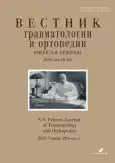Валидация и культурная адаптация шкалы KOOS-Child
- Авторы: Иванов Я.А.1, Ельцин А.Г.1, Мининков Д.С.1
-
Учреждения:
- Федеральное государственное бюджетное учреждение «Национальный медицинский исследовательский центр травматологии и ортопедии имени Н.Н. Приорова» Министерства здравоохранения Российской Федерации
- Выпуск: Том 28, № 1 (2021)
- Страницы: 53-64
- Раздел: Статьи
- URL: https://journals.rcsi.science/0869-8678/article/view/60489
- DOI: https://doi.org/10.17816/vto60489
- ID: 60489
Цитировать
Полный текст
Аннотация
Введение. В исследовании приняли участие 100 пациентов с такими видами повреждения коленного сустава, как повреждение менисков, передней и задней крестообразной связки, синдром медиопателлярной складки, рассекающий остеохондрит мыщелков бедренной кости. Возраст пациентов — до 18 лет, из них 51 мужского и 49 женского пола.
Цель исследования: валидация и культурная адаптация англоязычной шкалы оценки коленного сустава KOOS-Child для пациентов русскоговорящей языковой группы детского возраста с последующим применением в практике детского отделения ФГБУ «НМИЦ ТО им. Н.Н. Приорова» Минздрава России и других медицинских учреждениях Российской Федерации. Статья выполнена в рамках научно-исследовательской работы в ФГБУ «НМИЦ ТО им. Н.Н. Приорова» Минздрава России.
Материал и методы. Шкала KOOS-Child® была переведена на русский язык с английского травматологом-ортопедом со знанием английского языка на уровне advanced и профессиональным переводчиком, специализирующимся на переводе медицинских текстов. В качестве контрольной группы использовали опросник Lysholm, ранее используемый в отделении детской травматологии ФГБУ «НМИЦ ТО им. Н.Н. Приорова» Минздрава России. Затем был проведен статистический анализ, состоящий из трех этапов: общий анализ статистических данных, проверка валидности опросника, проверка адекватности и объективности результатов.
Заключение. Коэфициент α-теста Кронбаха в результате подсчета данных показывает очень высокий уровень согласованности вопросов (0,959). Задания опросника обладают высокой дискриминативностью, а результаты оценивания состояния пациентов адекватны и объективны. Методы статистического анализа показали, что с высокой доверительной вероятностью опросники соответствуют предметной области оценивания и их можно использовать в практических исследованиях.
Полный текст
Открыть статью на сайте журналаОб авторах
Ярослав Александрович Иванов
Федеральное государственное бюджетное учреждение «Национальный медицинский исследовательский центр травматологии и ортопедии имени Н.Н. Приорова» Министерства здравоохранения Российской Федерации
Автор, ответственный за переписку.
Email: docyaroslav@gmail.com
ORCID iD: 0000-0002-6352-2784
SPIN-код: 5575-4630
аспирант
Россия, 127299, Москва, ул. Приорова, д. 10Александр Геннадьевич Ельцин
Федеральное государственное бюджетное учреждение «Национальный медицинский исследовательский центр травматологии и ортопедии имени Н.Н. Приорова» Министерства здравоохранения Российской Федерации
Email: agyeltsin@gmail.com
SPIN-код: 6411-2484
канд. мед. наук
Россия, 127299, Москва, ул. Приорова, д. 10Дмитрий Сергеевич Мининков
Федеральное государственное бюджетное учреждение «Национальный медицинский исследовательский центр травматологии и ортопедии имени Н.Н. Приорова» Министерства здравоохранения Российской Федерации
Email: 45040311@mail.ru
SPIN-код: 1494-3179
канд. мед. наук
Россия, 127299, Москва, ул. Приорова, д. 10Список литературы
- Shanmugam C., Maffulli N. Sports injuries in children // Br Med Bull. 2008. Vol. 86. P. 33–57. doi: 10.1093/bmb/ldn001
- Schneider S., Yamamoto S., Weidmann C., Brühmann B. Sports injuries among adolescents: Incidence, causes and consequences // J Paediatr Child Health. 2012. Vol. 48, No. 10. P. E183–189. doi: 10.1111/j.1440-1754.2012.02578.x
- Finch C., Valuri G., Ozanne-Smith J. Sport and active recreation injuries in Australia: evidence from emergency department presentations // Br J Sports Med. 1998. Vol. 32, No. 3. P. 220–225. doi: 10.1136/bjsm.32.3.220
- Conn J.M., Annest J.L., Gilchrist J. Sports and recreation related injury episodes in the US population, 1997–99 // Inj Prev. 2003. Vol. 9, No. 2. P. 117–123. doi: 10.1136/ip.9.2.117
- Цыкунов М.Б. Использование категорий Международной классификации функционирования для оценки нарушений при патологии опорно-двигательной системы. Часть 2 (дискуссия) // Вестник травматологии и ортопедии им. Н.Н. Приорова. 2019. T. 26, № 2. С. 37–42. doi: 10.17116/vto201902137
- Hefti E., Müller W., Jakob R.P., Stäubli H.U. Evaluation of knee ligament injuries with the IKDC form // Knee Surg Sports Traumatol Arthrosc. 1993. Vol. 1, No. 3–4. P. 226–234. doi: 10.1007/BF01560215
- Irrgang J.J., Anderson A.F., Boland A.L., et al. Development and validation of the international knee documentation committee subjective knee form // Am J Sports Med. 2001. Vol. 29, No. 5. P. 600–613. doi: 10.1177/03635465010290051301
- Roos E.M., Roos H.P., Lohmander L.S., et al. Knee Injury and Osteoarthritis Outcome Score (KOOS) — development of a self-administered outcome measure // J Orthop Sports Phys Ther. 1998. Vol. 28, No. 2. P. 88–96. doi: 10.2519/jospt.1998.28.2.88
- Tegner Y., Lysholm J. Rating systems in the evaluation of knee ligament injuries // Clin Orthop Relat Res. 1985. No. 198. P. 43–49.
- Trottier E.R., Beauséjour M., Lamer S., et al. Validation of the French version of the KOOS-child questionnaire // Knee Surg Sports Traumatol Arthrosc. 2019. Vol. 27, No. 7. P. 2361–2367. doi: 10.1007/s00167-018-5302-y
- Moutzouri M., Tsoumpos P., Bania T., et al. Greek KOOS-Child: a valid, disease specific, diagnostically accurate and responsive PROM in children with knee-related pathology // Knee Surg Sports Traumatol Arthrosc. 2020. doi: 10.1007/s00167-020-06237-5
- Ardern C.L., Ekas G.R., Grindem H., et al. 2018 International Olympic Committee consensus statement on prevention, diagnosis and management of paediatric anterior cruciate ligament (ACL) injuries // Br J Sports Med. 2018. Vol. 52, No 7. P. 422–438. doi: 10.1136/bjsports-2018-099060
- Beaton D.E., Bombardier C., Guillemin F., Ferraz M.B. Guidelines for the process of cross-cultural adaptation of self-report measures // Spine (Phila Pa 1976). 2000. Vol. 25, No. 24. P. 3186–3191. doi: 10.1097/00007632-200012150-00014
- Боровков А.А. Математическая статистика. 4-е изд. Санкт-Петербург: Лань, 2010. 704 c.
- Гласс Дж. Статистические методы в психологии. Москва: Прогресс, 1976.
- Захаров В.П. Применение математических методов в социально-психологических исследованиях. Ленинград: ЛГУ, 1985.
- Анастази А. Психологическое тестирование. Кн. 1. / пер. с англ., под ред. К.М. Гуревича, В.И. Лубовского. Москва: Педагогика, 1982. 320 с.
- Cronbach L.J. Coefficient alpha and the internal structure of tests // Psychometrika. 1951. No. 16. P. 297–334.
- Справочник по прикладной статистике. Москва: Финансы и статистика, 1990.
Дополнительные файлы










